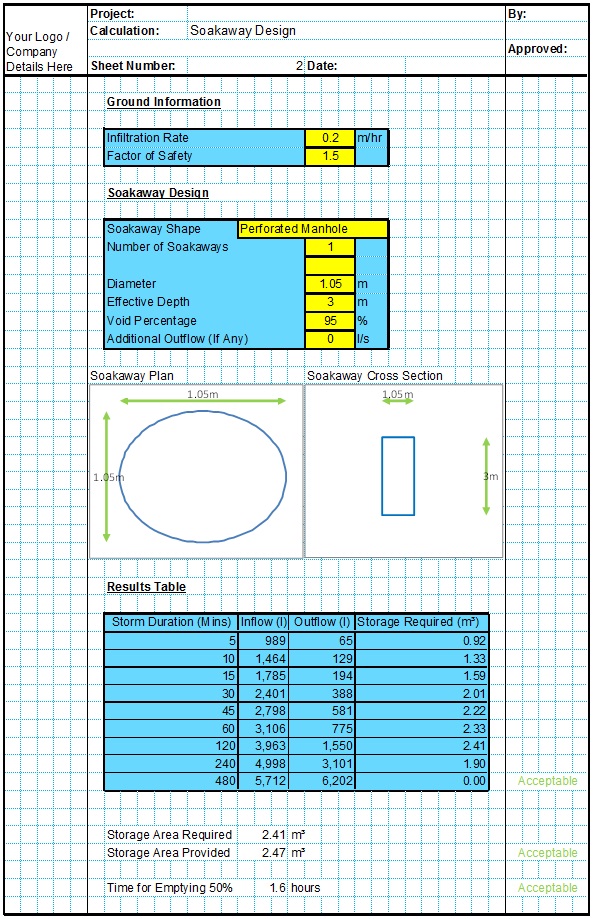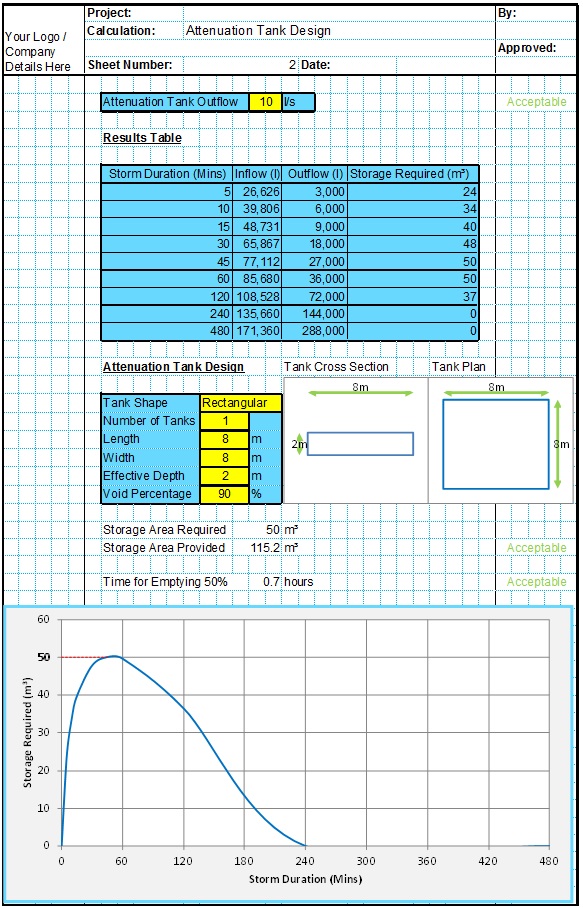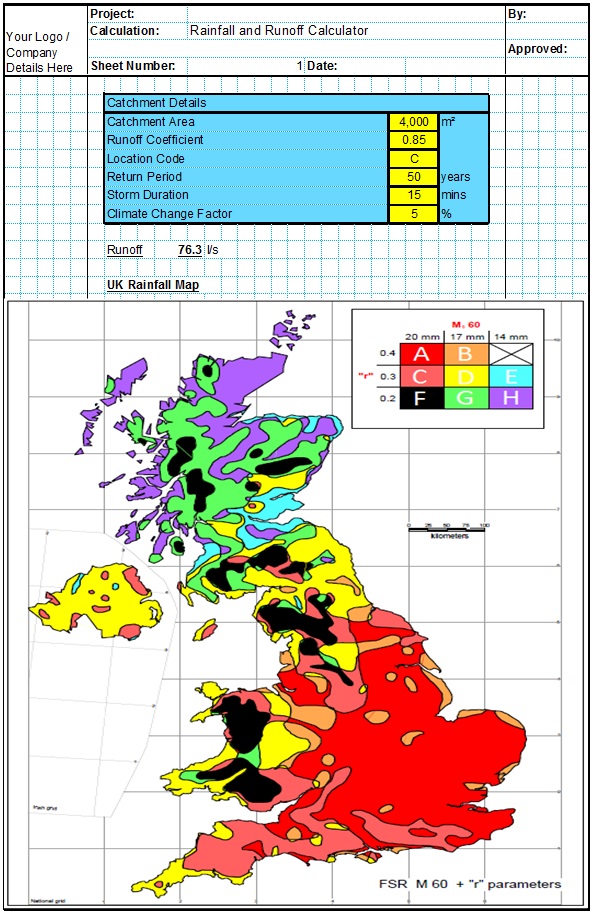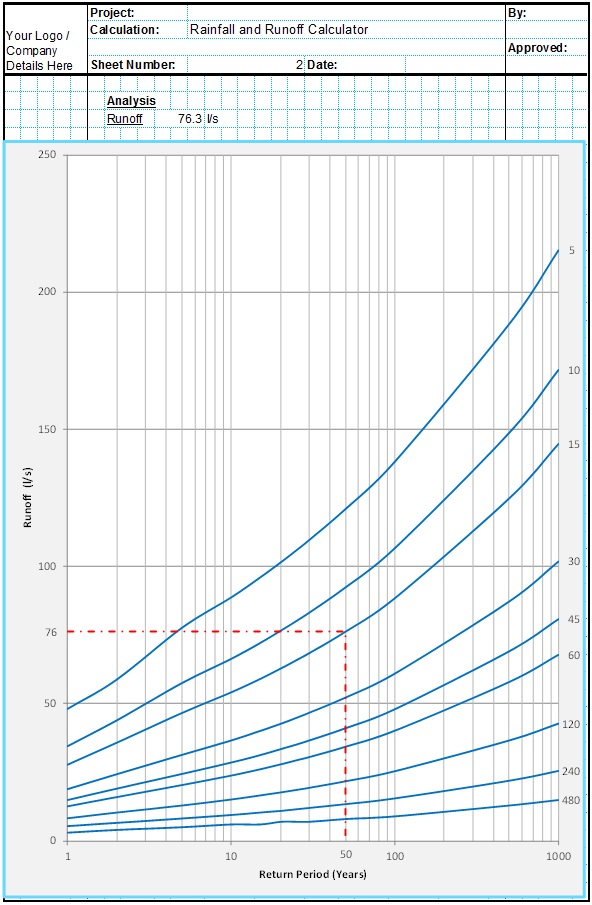Soakaways can typically be constructed at any depth between 1.5m and 7.0m deep. The deeper the soakaway is the better its infiltration performance and storage capacity. However, soakaways any deeper than around 3.0m can become difficult and more expensive to build. Garden or driveway soakaways are usually much smaller than commercial applications though they would usually still be at least 1.0m - 1.5m deep.
Soakaway Size Calculations
The required size of a rainwater soakaway must be calculated to ensure that the soakaway is large enough to store the required runoff. The required volume of water is calculated from the difference between the runoff entering the soakaway from a storm event of a particular duration, and the water which infiltrates into the surrounding soils during the storm event. This is one of the most important factors in soakaway design.
The depth of the soakaway is usually the most important factor when sizing a soakaway. This is because the deeper the soakaway is, the greater the surface area available for infiltration and the greater the volume available for storage. The effect of larger diameter soakaways is similar but a deeper soakaway is more effective at increasing the infiltration.
As the size and depth of a soakaway both increases the storage available and decreases the storage required, sizing a soakaway is an iterative process unless a spreadsheet is used such as the CivilWeb Soakaway Design Spreadsheet.
Soakaway Size Applications
Soakaway crate systems are affected by the same considerations but as the void ratio in soakaway crates is so large it is often sufficient simply to size the soakaway to suit the storage volume required, neglecting the increased infiltration rates afforded by a deeper soakaway.
Conventional soakaway pit systems often consist of a soakaway chamber with a large void ratio and a backfilled annulus with a smaller void ratio. In this case the size of the soakaway chamber and the excavated annulus can be optimized during the soakaway pit design process. However, in many cases the storage volume provided in the annulus is small compared to the storage chamber and can decrease over time due to sediments collecting from the runoff. For this reason the storage capacity of the annulus area is sometimes neglected.
This can lead to a different situation to other rainwater soakaway designs as the storage capacity is largely decided by the size of the chamber and the infiltration is dependent on the size of the excavation. In this case it can be easier to optimize the soakaway size as both terms can be manipulated in isolation from the other.
Trench soakaway design is different in that the storage volume is relatively small as the whole soakaway is usually backfilled except for a small diameter soakaway pipe. Trench soakaways are often sized simply to suit excavation equipment as the large infiltration surface area provided is often suitable to remove the runoff before there is a requirement for a large storage volume.
Design Storm Event
The pit should be sized to accommodate the inflow from the worst case design storm event. This is the storm event that results in the largest difference between the inflow volume and the outflow volume from infiltration to the surrounding soils.
This can be done by hand but is much quicker and more accurate to use a computer program or spreadsheet such as the CivilWeb Soakaway Design Spreadsheet which can instantly analyse all the possible storm durations and determine the worst case.
Soakaway Construction
Generally where a precast concrete storage ring is used, the sides of the square pit should be around twice the diameter of the precast rings with the annulus filled with clean granular material. This will allow enough space for the ring to be installed and the additional volume of the annulus can be added to the overall storage capacity of the soakaway.
In all cases there should be at least 300mm of backfill surrounding all sides of the precast units. This allows the backfill to disperse the concentrated flow coming from the soakaway perforations preventing the risk of scour or washout of the surrounding soils and allowing the full surface area of the interface to be effective for infiltration.
Related Spreadsheets from CivilWeb;
Soakaway Design Spreadsheet
This spreadsheet calculates the requirements for a soakaway system and assists the user to design a suitable system.
Attenuation Design Spreadsheet
This spreadsheet calculates the requirements for a attenuation system and assists the user to design a suitable system.
Runoff Calculator Spreadsheet
This spreadsheet calculates the design runoff flow for a site in accordance with the a number of different methods including the Wallingford Procedure.
Full Drainage Design Suite
Full drainage design suite (50% Discount) including 7 spreadsheets;
- Colebrook White Pipe Design
- Manning Pipe Design
- Manning Open Channel Design
- Linear Drainage Design
- Runoff Calculator
- Attenuation Design
- Soakaway Design



